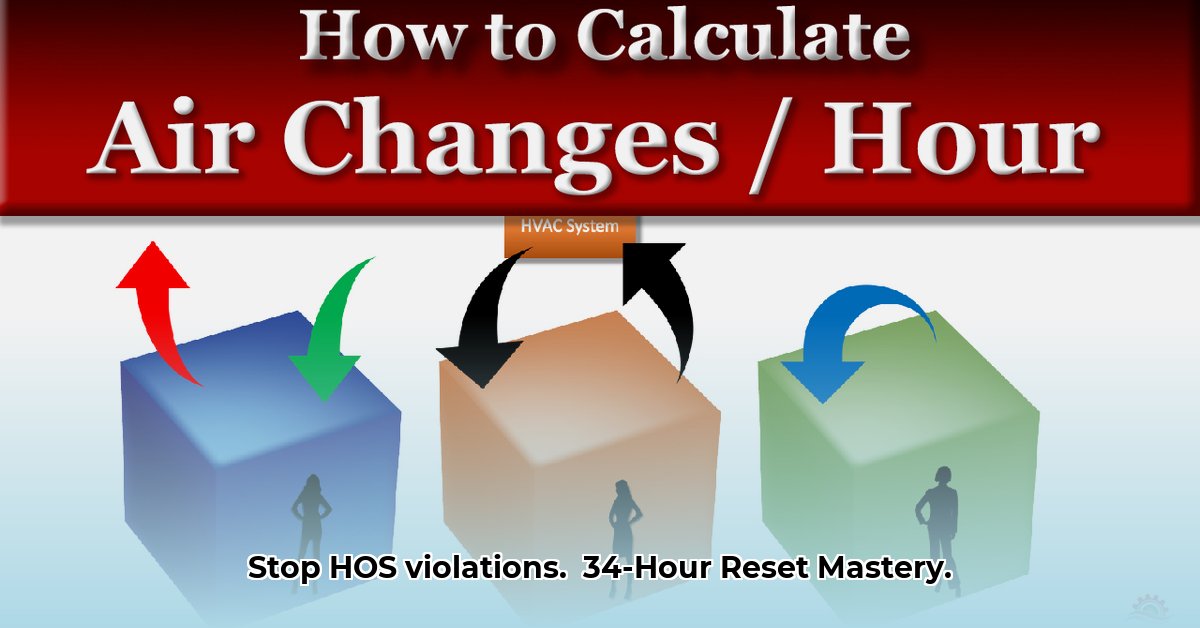
The 34-hour restart rule, a cornerstone of the Hours of Service (HOS) regulations, is crucial for truck driver safety and compliance. Miscalculating this rest period can lead to significant fines and jeopardize your safety and the safety of others on the road. This guide provides clear, step-by-step instructions for calculating your 34-hour reset, highlighting both simple and formula-based methods, and emphasizing the importance of using digital tools for accuracy. We'll also explore the legal ramifications of non-compliance and offer best practices for drivers, trucking companies, and regulatory bodies.
Understanding the 34-Hour Reset and its Importance
Accurate calculation of the 34-hour reset is paramount for complying with Federal Motor Carrier Safety Administration (FMCSA) regulations. Driver fatigue is a significant contributor to accidents, and the 34-hour reset is designed to mitigate this risk by mandating sufficient rest periods. Failing to comply can result in substantial fines, license suspension, and even legal action. Isn't accurate calculation worth the effort to protect yourself and others?
Two Methods for Calculating Your 34-Hour Break
Two primary methods exist for calculating your 34-hour reset: simple addition and a formula-based approach. Each has its advantages and disadvantages, impacting accuracy and the likelihood of errors.
Method 1: Simple Addition – Quick, but Risky
This method involves simply adding 34 hours to your initial break start time. For instance, a break beginning at 6:00 PM on Monday ends at approximately 6:00 AM on Wednesday.
- Pros: Simplicity and speed of calculation.
- Cons: Fails to account for interruptions or shorter breaks within the 34-hour period, leading to potential inaccuracies and HOS violations. This method is prone to errors and should be avoided for reliable compliance.
Method 2: The Formula Approach – More Precise, More Complex
This method offers greater precision by factoring in any time spent working, driving, or on-duty during the 34-hour period. The formula is: Remaining Time = 34 hours - (Hours Worked + (Minutes Worked / 60)).
For example: If you worked 10 hours and 30 minutes, the calculation is: Remaining Time = 34 - (10 + (30/60)) = 23.5 hours.
- Pros: Superior accuracy due to accounting for all interruptions.
- Cons: Requires more detailed record-keeping and a higher degree of calculation precision, increasing the risk of human error. This risk can be mitigated with careful attention and double-checking.
Digital Tools: The Key to Accurate and Efficient Calculations
Dedicated 34-hour reset calculators – available as websites and mobile apps – significantly reduce calculation errors. They automate the process, minimizing the risk of human error and providing an efficient, accurate result. Many reputable options offer a visual timer function. However, always verify results independently, particularly with free applications.
How can you ensure you're using the best tools for the job and minimizing risks associated with driver fatigue and HOS violations? Choosing a reliable digital calculator is critical.
The Legal Ramifications and Best Practices for Compliance
Non-compliance with HOS regulations carries severe consequences including substantial fines, potential loss of operating authority, and legal repercussions. Beyond the legal ramifications, prioritizing driver safety is paramount. Driver fatigue significantly contributes to accidents, making accurate 34-hour reset calculation far more than a regulatory requirement—it’s a matter of life and death.
Recommendations for All Stakeholders:
- Drivers: Utilize reliable digital 34-hour reset calculators, maintain meticulous logs, and thoroughly understand the regulations. Don’t rely on memory alone.
- Trucking Companies: Invest in comprehensive driver training programs, equip drivers with dependable digital tools, and foster a culture of compliance.
- Regulatory Bodies (e.g., FMCSA): Continue to promote the use of accurate tracking systems and provide clear, easily accessible guidelines to ensure consistent and accurate compliance.
Risk Assessment: The risk of non-compliance increases significantly with the simple addition method due to its inherent inaccuracy. The formula-based approach presents a moderate risk, which can be reduced through careful record-keeping and double-checking. Digital tools minimize this risk dramatically.
Conclusion: Prioritize Accuracy and Safety
Mastering the 34-hour reset calculation is non-negotiable for all truck drivers. While the simple addition method is easy, its inaccuracy makes it a high-risk option. The formula-based method offers improved accuracy but requires careful calculation. Using a dedicated digital tool is the most effective approach, minimizing errors and maximizing compliance. Remember, prioritizing accurate calculations is not just about avoiding fines – it's about ensuring your safety and the safety of others on the road. Compliance is a shared responsibility requiring diligence from drivers, companies, and regulatory bodies alike.